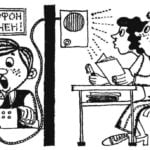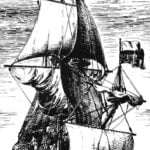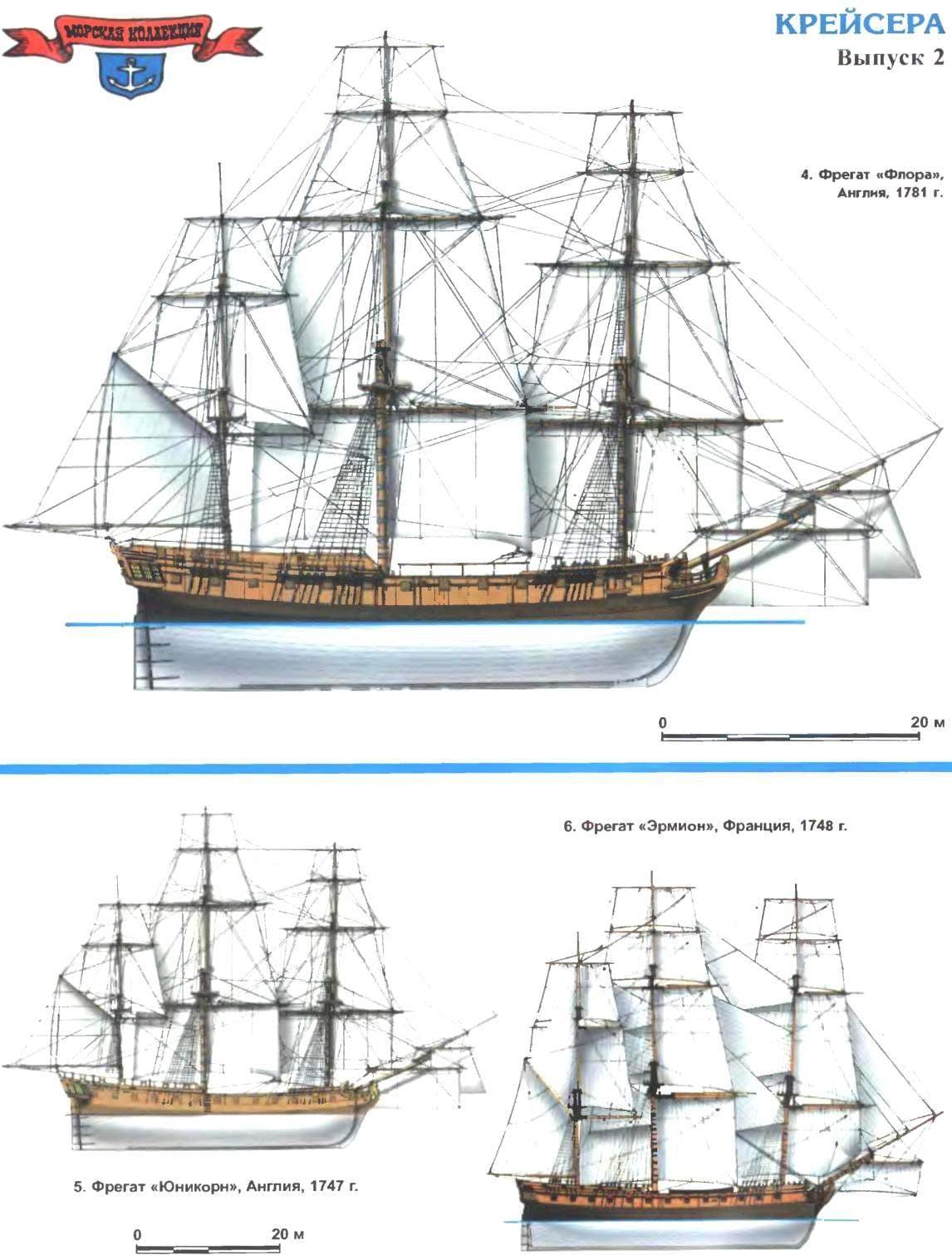 From the point of view of war at sea the eighteenth century has largely been a century frigates. For over a hundred years three major powers of Europe were engaged in a military struggle, often in the most remote corners of the globe. The war of the Austrian succession, Seven years war, the war for independence of the North American States, finally, the Napoleonic wars… At every opportunity, England, France and Spain entered the confrontation, hoping the campaign to acquire overseas possessions of the enemy. Of course, when military action occurred over many thousands of miles from Europe, the importance of acquired fleet. And not only ships of the line, formed the basis of combat squadrons, but also smaller vessels — frigates and corvettes capable of a cruising operation as the composition of the group, and alone.
From the point of view of war at sea the eighteenth century has largely been a century frigates. For over a hundred years three major powers of Europe were engaged in a military struggle, often in the most remote corners of the globe. The war of the Austrian succession, Seven years war, the war for independence of the North American States, finally, the Napoleonic wars… At every opportunity, England, France and Spain entered the confrontation, hoping the campaign to acquire overseas possessions of the enemy. Of course, when military action occurred over many thousands of miles from Europe, the importance of acquired fleet. And not only ships of the line, formed the basis of combat squadrons, but also smaller vessels — frigates and corvettes capable of a cruising operation as the composition of the group, and alone.
At first glance at the lists of ships sailing fleets of the time catches the eye too much diversity as frigates in tonnage and sizes, and their weaponry. The impression that class frigates often carried different and not similar to each other court. However, it is not so. The British, the French sought to standardize its units. In England for this purpose they used the so-called “Code of types” (the regulations), which recorded the size, number of guns and such important structural elements as the distance between the frames, the thickness Besov and other structural relationships that affect the strength of the building. The first “Code” refers to 1706. At this time England was at war with Spain, and problems of standardization was serious. Prior to that, British shipbuilders as prototypes often chose ships based at the Dunkirk corsairs. The British clearly overdone: long and low hull of their ships, really good for actions in coastal waters, for ships 3 rank (i.e. 60-gun battleships) was of little use. British military sailing was fast, but the stability and seaworthiness clearly did not meet the conditions of a long ocean trips. During the battle, in fresh weather, too close to the water ports filled with water, which prevented the fire. So the situation remained for half a century, while the admirals decided to move to absolutely other principles of ship design.
According to the regulations 1706 provided for two types of frigates: 20-cannon and 30 cannon. The British froze the length of their shells, while increasing the width, resulting in increased stability of ships. Closely set transverse frames and deck beams created a very solid construction that did not require repairs for several years. The result is a strong, reliable, fairly cheap to operate warships, well suited for service in the overseas colonies.
According to the regulations 1733 width frigates increased even more, as it was decided to give the ships of all classes the same relation to its length. The length has remained unchanged, the same as the number of weapons: 20 small frigates 6 grade and 40 for “linear” (30-pushechnikov and left on paper) is because they adopted the personal signature of the king!
Meanwhile, the French and the Spaniards quietly increased the size of their ships of different classes, including frigates, and all the time experimented with the area and location of sails. So when in 1739 began another war with Spain, the English cruisers once again had a hard time. Urgently needed to change the standards. In 1741 appeared the temporary rules that allowed (or rather — highly recommended) to increase the length of ships of all classes — for the first time in 20 years.
As for other things, the design of the British frigates remained, to put it mildly, very conservative. First of all, even the smallest 20-pushechnikov guns located on two decks. At the same time on the bottom (keep the historical name “gun”; had only two guns on Board, because the rest of the space on it was occupied by small ports for 15 pairs of oars, which are almost never used! The result is a real gun deck — open top — had to be lifted high above the waterline, which in turn led to problems with stability (the frigates were forced to make the hold a fair amount of ballast). This is a fairly ridiculous location of the artillery had one advantage: guns of the lower deck (at the same time also played the role of a kind of ballast) could have a larger caliber. Usually put there, as mentioned earlier, a pair of 9-fotovac on Board, which was supplemented with 6-pound guns upper deck.
However, in any case, the armament, in comparison with the French “opponents” remained very weak. Not having restrictions in the size of the ships, the French built many large frigates with two full gun decks. They carried from 28 to 36 guns, of which from 8 to 12 guns (8 – or 12-pounders) was located on the lower deck, and the rest (like the British 6-pounder) is on the top.
In addition to large two-decked frigates, the French in 1742, began the construction of ships of smaller size, all the guns which were located on the upper deck. Below they had another deck, but since it was not the ports, it could be on the waterline or even below it. In the end, the French frigates of the new model, the first of which was the 26-gun “Medea”, had a greater stability. The low case had a smaller mass, and his set did not differ so considerable thoroughness, as the British frigates. Their masts, respectively, could be much higher, which together with a large elongation and good lines made “French” fleet in comparison with the clumsy and tall “British”. In addition, the increased windage and ease on the move gave them great maneuverability. In the battle the French ships did not hesitate to take the leeward position, leaving the enemy to windward. The British have always sought to take a more advantageous, as they thought, the windward position. However, in most cases, the benefit was just on the side of the enemy. With the approach of the British ships had to go quite cool in the wind, substituting for longitudinal enemy fire for as long as they are not unfolded the Board opposite to the chosen to fight the enemy. In the case of severe damage to the windward, the ship drifted helplessly towards the enemy, further weakening his position. Knocked out of the line frigate of the French could just turn into the wind and away from persecution.
All these advantages have not gone unnoticed “mistress of the seas”. During the war of the Austrian succession (1744 — 1748 years) the British managed to capture a dozen French frigates, carrying from 22 to 40 guns, including the notorious “Medea”. Interestingly, they all fell into the hands of the enemy in battles with ships of the British ships of the same rank, they were not the teeth.

4. The frigate flora, England, 1781
The first British frigate with 18-pounder artillery was built at the shipyard in Deptford. The displacement of 869 tons, length on deck 41.8 m, width 11,6 m, draught 4.7 metres Armament: twenty-six 18-pounders and six 9-pounder guns. Killed in the accident in 1808
5. The frigate “unicorn”, England, 1747
The first British 28-gun frigate, was built at the shipyard in Plymouth. The tonnage 581 tons, length on deck of 35.9 m, beam of 10.3 m, draft 3.03 m Armament: twenty-eight 9-pounder guns. Scrapped in 1771, the Good ship, was the prototype of a series of 21 units built before 1766
6. The frigate “Hermione”, France, 1748
The first French frigate with 12-pounder guns, was built at the shipyard in Rochefort. A displacement of 812 tons, length on deck of 39.9 m, beam of 11.43 m, draught 4,1 m. Armament: twenty-eight 12-pounder guns. Captured in 1757 by the British 28-gun frigate “unicorn”.
Having obtained the desired samples, the British subjected them to careful study. The outcome was quite unexpected. Recognizing the good performance of the French frigates, shipbuilders categorically claimed that they… it is not suitable for the British Navy. Standards of the fleet “mistress of the seas” was not satisfied with almost everything and is too lightweight construction with flimsy fastenings of the hull and decks, and insufficient space to accommodate teams, and small ammunition, and the cost of maintenance. On top of that particular criticism has caused materials. In England, the ship’s wood has aged for many years before embarking in business. The French used a more “fresh” tree. Moreover, it seems at first glance an innovative use of iron nails instead of wooden caused significant corrosion. A higher mast with a weak set and mount much shook the building. For reviews of seafarers, a large (40-gun) captured the frigate “Ambuscade”, descended from the stocks of less than a year ago, looked like served for several years. Trophies often had to send for overhaul Usually the term of their service in the Royal Navy rarely exceeded five or seven years. And the price of capital repairs sometimes exceeded the construction cost of the new frigates under its standards. Convinced of this, for example, the processors 26-gun frigate, with the eloquent title “La Subtile”, to be completely new, but fit for duty except for two or three years. Actually, this time — three years — and was a “Golden age” of French frigates during which they really possessed the advantage of speed.
Another disadvantage of lightweight construction became a relatively weak arms “French”. Taking in 1745, the 24-gun frigate “Panther”, the British with some surprise convinced that you can’t replace it with 6-pound guns on the now-standard 9-funtouki. When volley firing seemed that the case “Amazon” (as he called the trophy) might be about to crumble.
It is fair to say that some French frigates still found its place in the fleet of the enemy. Captured in 1747 30-gun “Reputation”, renamed “Renown”, very much British seamen. He served until 1771, however, the British had to produce three to overhaul at least two of which cost as much or more than a brand new 32-gun frigate!
Thus, it would seem that the undoubted superiority of the French sailing shipbuilding partially was a myth. In fact, everything depended on the approach. The British built their cruisers for long-lasting service is mainly escort. Long ocean voyages could take place in all weather conditions. Hence, robust design of larger facilities for the team, spacious pantries and cellars of ammunition. The French built frigates and corvettes are mostly for raids. At the forefront were the qualities of good speed and maneuverability Easy cruiser with a large sail became very efficient in low wind. He could in broad daylight to get between the escort and protected by the courts and attack them with the full superiority of the enemy. And such attacks do not just took place. On the contrary, when the wind freshened from the high masts had to lower the sails, while the cruisers of the British only added to the course. French frigates started to experience the strongest keel and rolling and filled with water, and the enemy could take them almost bare hands (of course, if weather didn’t spoil the final).
British shipbuilders, not abandoning such positive qualities as strength of construction, tried to adopt more graceful hull form and General arrangement of the frigates of his now clearly the main and only enemy of the sea. British cruisers finally disappeared ridiculous paddle and flawed “gun” deck with almost no guns. Case with one gun deck below, though still remained slightly higher than the continental “colleagues”.
Led the reform of the famous Admiral George Anson. It was he who gave orders for the construction of the first full-fledged British frigates: 28-cannon. “The unicorn” and “lime” (the first of them was the head for a great series). He decided to replace the old double-deck 24 – and 44-pushechnikov a new standard type of “French” lines and one open deck with 12 32-pound cannons. The new standard was called to the fact that the restless French in 1748 created a “12-pound” frigate (“Hermione”),
Meanwhile, between the French “lilies” and the British “lion” has been brewing for the next Seven years ‘ war, England was forced to reform its cruising fleet is already in military terms.
The case decided the case. One of the two main designers of the Royal Navy Thomas Slade, notice to dry dock built in Canada cruiser “L Abenakis”, the beautiful lines which at first sight made a strong impression on him. As a result, the drawings of all new British frigates had traits of the beautiful canadian. The result was a compromise, very attractive from the point of view of the Admiralty. Now length correspond to the French competitors, but the case had a deeper draft, which allowed to arrange rooms and pantries spacious. Strength requirements of the design were presented the same hard, and it has borne fruit. English 32-gun frigate safely carried 12-pounder guns, while the similar size of the enemy were forced to settle for only 8 pound.
The case has remained higher among other considerations, the reason for this decision was the fact that the British cruisers were mostly the “windward” ships. Their guns were required to be placed above, because the wind was banking the body in the direction of the enemy, and the kernel is forced to fall mostly into the housing (at a lower position, they would hit water). In contrast, the low case “French” could not be more consistent with their downwind tactics: ships careened into the side of the opponent, and the core flew upwards, often getting in the sails and the mast. This situation has led to another legend that the British preferred to shoot the hulls of the enemy, while the French on the railing, trying to deprive the enemy of progress. In reality, the reason probably lay in tactics and design, not a direct desire of the gunners.
The new standard proved to be surprisingly tenacious. From the middle almost to the end of the XVIII century, all 32-gun British frigate was an integrated type; in total there were built about 60 pieces, Many of them managed to participate in the main and final test of the English sailing fleet — Napoleonic wars.
V. KOFMAN
Recommend to read
 CAUSE the 9th “A”
CAUSE the 9th “A”
In the staff room phone rang: asked physics teachers. Some of those present said: "Now it's in the shop". How to be? Because the school has no internal telephone communication and... THE FIRST SHIP OF THE FIRST OF THE ADMIRALTY
THE FIRST SHIP OF THE FIRST OF THE ADMIRALTY
"Eagle" - the first Russian two-decked warship was built in 1669. The shipyard was laid in the village of Dedinovo, 26 km from Kolomna. This place is on the left Bank of the Oka river at...
 From the point of view of war at sea the eighteenth century has largely been a century frigates. For over a hundred years three major powers of Europe were engaged in a military struggle, often in the most remote corners of the globe. The war of the Austrian succession, Seven years war, the war for independence of the North American States, finally, the Napoleonic wars… At every opportunity, England, France and Spain entered the confrontation, hoping the campaign to acquire overseas possessions of the enemy. Of course, when military action occurred over many thousands of miles from Europe, the importance of acquired fleet. And not only ships of the line, formed the basis of combat squadrons, but also smaller vessels — frigates and corvettes capable of a cruising operation as the composition of the group, and alone.
From the point of view of war at sea the eighteenth century has largely been a century frigates. For over a hundred years three major powers of Europe were engaged in a military struggle, often in the most remote corners of the globe. The war of the Austrian succession, Seven years war, the war for independence of the North American States, finally, the Napoleonic wars… At every opportunity, England, France and Spain entered the confrontation, hoping the campaign to acquire overseas possessions of the enemy. Of course, when military action occurred over many thousands of miles from Europe, the importance of acquired fleet. And not only ships of the line, formed the basis of combat squadrons, but also smaller vessels — frigates and corvettes capable of a cruising operation as the composition of the group, and alone.



